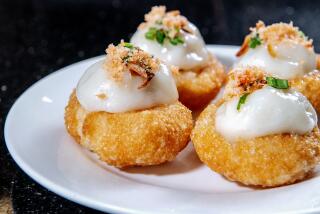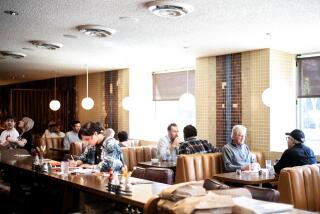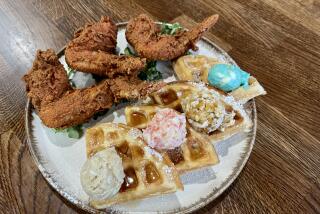Rows by Any Other Name Would Sell as Sweet : Tudor-era shop galleries attract visitors to Chester on England’s west coast.
- Share via
CHESTER, England — Few plac-es conjure up a nostalgic image of England’s colorful past as well as the magnificent Rows of this ancient walled city.
These Tudor-era, twin-tiered shops--set beneath the black-and-white, half-timbered second stories of Chester’s main streets--are accessible both at street level and from covered galleries one floor above, making the town a shopper’s delight, rain or shine.
The striking visual effect of the Rows is so magical that Dr. Samuel Johnson’s biographer, James Boswell, wrote to his mentor in 1779: “I am in a state of much enjoyment . . . Chester pleases my fancy more than any town I ever saw.”
Indeed, many rank the Rows with Stonehenge, Anne Hathaway’s Cottage, the Tower of London and perhaps the first notes of “Rule, Brittania” as their most powerful memories of England.
Built around AD 79 as a walled Roman fortress against the marauding Welsh, Chester remains the only completely walled city in England, although many of the ramparts, towers and gates were added or rebuilt during the Middle Ages. While the Romans laid out the fairly orderly street grid inside the walls, they departed about AD 383, and little of note happened until the town was captured by William of Normandy shortly after the Battle of Hastings in 1066.
During medieval times, Chester had access to the Irish Sea via the River Dee and was one of the country’s major ports for world trade. But when the Dee silted up, the former fishing village of Liverpool took over and is still western England’s largest port.
The Tudor era (1485-1603) was the period during which Chester took on the distinct look that sets it apart today. It was also a time of great prosperity, with regular markets, annual trade fairs and the town’s Mystery Plays. These Biblical plays were presented around the city on makeshift outdoor stages. The Waterdrawers’ Guild enacted the Great Flood; the Bakers’ Guild staged the Last Supper.
The 18th Century also saw continued prosperity in Chester. At one time there were 140 licensed inns and taverns in the busy town. Some of them are still in business, bedding, and pulling pints for, customers.
Getting settled in: Built as a private home in 1520, Ye Olde King’s Head typifies Chester’s Tudor period as well as any building in town. The inn is a warren of passageways and rough-hewn oak beams that surely must be the originals, so keep your eyes peeled for “Mind Your Head” signs or suffer a few knocks.
There’s a pub on the first floor with a fireplace and a fine old wooden bar, a restaurant upstairs (more later). Some bedrooms have four-posters, but most of the less expensive rooms are furnished simply. The King’s Head is right at the center of things, near Rows shops on Watergate and Eastgate streets.
The late-Victorian Green Bough Hotel has more the feeling of a homey bed-and-breakfast, although there’s a full restaurant. Public room furnishings are somewhere between very busy and cluttered, yet the Edwardian bar is a handsome focal point of the house with its leather-wing chairs and turn-of-the-century decor.
The Green Bough’s 19 bedrooms all have TV, hair dryers and coffee- and tea-making gear. The hotel is on a main street leading into downtown Chester, a short drive.
Back in 1647, the Blossoms Hotel was the Chester-London stage-stop terminal. It has been on the city scene ever since. Now it’s Edwardian in the very refined manner of that period, with a marvelous staircase leading from the lobby, paneled walls and gilt-framed old pictures in the dining room.
Bedrooms are very spacious and decorated in the same tasteful manner as public areas. There are also big-hotel amenities and the standard “self-catering” equipment for tea and coffee. Many upstairs rooms have fine views of the city’s rooftops, and Blossoms is very central.
Good local dining: Being the oldest domestic structure in a town such as Chester is something special indeed. The Blue Bell (65 Northgate St.) was first licensed as an ale house in 1494. It has since been a home, shop and coaching stop, reopening as a tavern in 1807. The facade still has a medieval feel to it and the interior has an old fireplace, blackboard menu and tight little nosegays on each table.
A blackboard special during our lunch was toad-in-the-hole, a banger (British sausage) wrapped and cooked in a Yorkshire-pudding-type dough. This joined such English staples as a ploughman’s lunch (Cheshire and Stilton cheeses, French bread, butter, homemade chutney and salad) and Welsh rarebit. A few French dishes join these as main courses (most in the $6.50-$8 range), and for another $3, one may add a starter and dessert. The food was awfully good.
The restaurant at Ye Olde King’s Head (48 Lower Bridge St.), Hudson’s, is on the second floor. It has the same rustic atmosphere of the hotel and sticks pretty much to basic British food. Have a go at the steak-and-mushroom pie, honey-roasted duckling or pork fillet cooked with sage. Expect to pay about $13 for these, but there are set meals for around $8.
Restaurant-Pizzeria Mamma Mia (St. Werburge Street) radiates the sunny climes of Italy in a pretty place that’s family owned. There are 15 pizzas (all about $7), a like number of pastas at the same price, and more than a dozen main dishes of Italian-style veal, beef and chicken in the $15 range, plus starters and desserts. The house wine is $6 for a half-liter carafe,and there are 16 other bottles from most regions of Italy.
Going first-class: For more than nine centuries, the Grosvenor family has owned lands around Chester, and in 1800 they acquired a mid-town hotel. In 1866, the new Chester Grosvenor opened on the same site, and it has been the city’s premier hostelry since. It is still a part of the Grosvenor Estates, and is looked after by the present Duke of Westminster.
Everything about the Grosvenor is absolutely first-cabin and luxurious, from the elegant Library and residents’ drawing room, both perfect settings for a drink or afternoon tea, to the Michelin-star Arkle restaurant, named for the Duchess of Westminster’s renowned steeplechaser.
First courses at the elegant Arkle include a risotto of wild mushrooms and prosciutto, or chilled oysters with a pate of fennel and caviar. Main dishes might be carre d’agneau , lamb roasted with sweet garlic Lyonnaise style, or a saddle of venison with cabbage and game sausage. Expect to pay about $65 per person plus wine. La Brasserie is the Grosvenor’s fine but less-pricey dining room, albeit a bit prettier than a typical Gallic brasserie .
On your own: For a true overview of Chester, take a walk around the old Roman walls. You may even join a group to accompany the “Roman legionnaire,” Caius Julius Quartus, who will explain (in full battle gear) how things were in Chester in AD 100. The cost is about $1.60. That’s the same as for the Ale Trail, a tippler’s trek covering the routes of Romans, Normans, Cromwell’s troops, smugglers and highwaymen as they combed Chester’s historic inns and taverns looking for a splash of local spirits.
Chester’s 12th-Century cathedral has lovely cloisters, magnificent 14th-Century carved choir stalls and fine stained-glass windows done only three decades ago.
At noon and 3 p.m. in summer, head for The Cross, where four of the main Rows converge. This is when the town crier rings in to let folks know all the latest local tidings, plus news hot off the coach from London, followed by buskers and other street entertainment.
GUIDEBOOK
Yes, Sir, It’s Chester
Getting there: British Airways recently began the only nonstop service from Los Angeles to Manchester. An advance-purchase, round-trip ticket costs $639 until June 15; after that, the price rises to $769. From Manchester, it’s a 42-mile drive to Chester.
A few fast facts: Britain’s pound sterling recently sold for $1.60. Visit Chester anytime from late spring until late fall, and don’t forget to bring a light raincoat and brolly, whatever the month.
Where to stay: Ye Olde King’s Head (48 Lower Bridge St., from U.S. phones 011-44-0244-324855; $81.60 double, full English breakfasts); Green Bough Hotel (60 Hoole Road, tel. 011-44-0244- 326241; $78.50 double, English breakfasts); Blossoms Hotel (St. John Street, tel. 011-44-0244-323186; $141 double); Chester Grosvenor (Eastgate Street, tel. (800) 525-4800; $236 double).
For more information: Call the British Tourist Authority at (213) 628-3525, or write (350 S. Figueroa St., Suite 450, Los Angeles 90071) for a booklet on Chester, plus a packet of general information on travel in Britain.
More to Read
Sign up for The Wild
We’ll help you find the best places to hike, bike and run, as well as the perfect silent spots for meditation and yoga.
You may occasionally receive promotional content from the Los Angeles Times.






